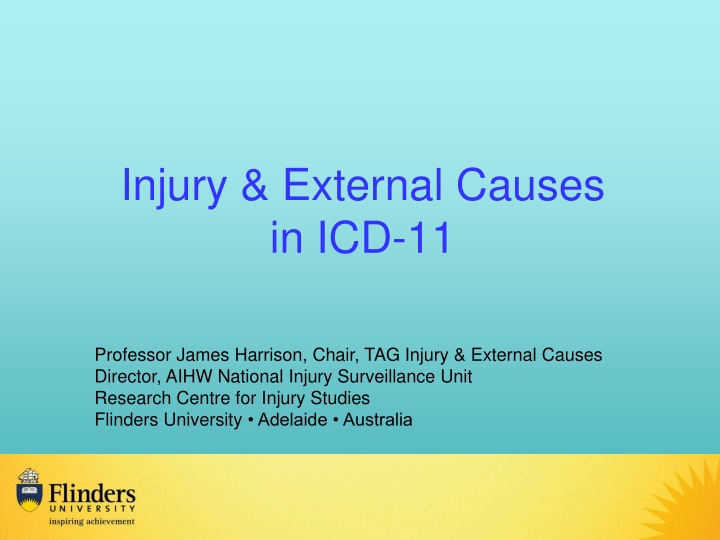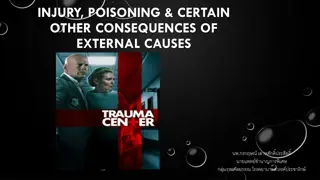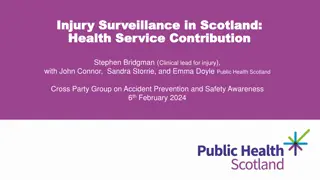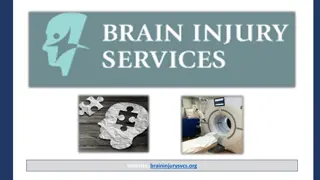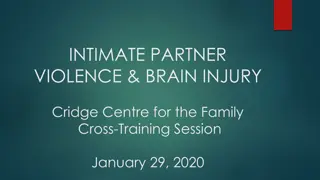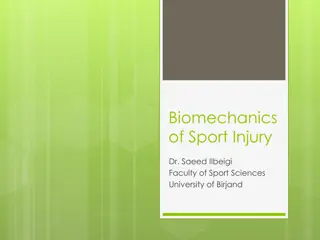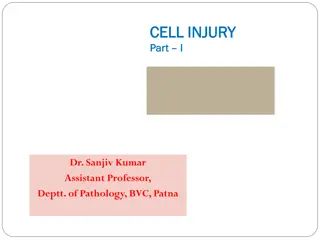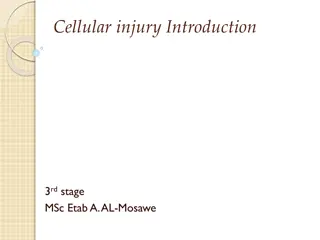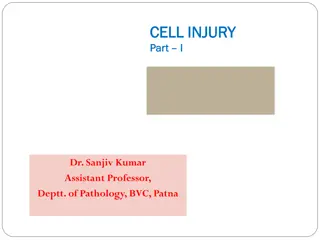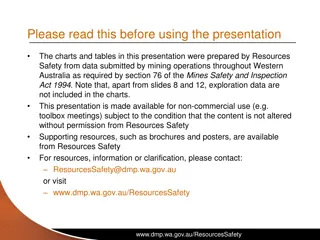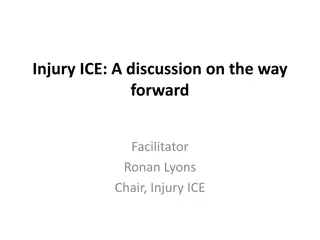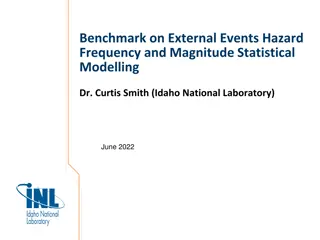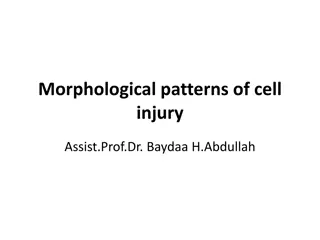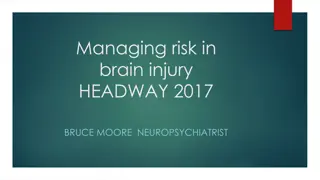Injury & External Causes
This content delves into the proposals and revision overview of Injury & External Causes in ICD-11, presented by Professor James Harrison. It covers the background, principles, and proposed changes in the classification. Insights are provided on the clinical modifications, overlap issues, and major structural changes from ICD-10 to ICD-11. The focus is on addressing clinical demand and enhancing the content beyond the existing framework, with a keen eye on clinical uses and extensions.
Download Presentation

Please find below an Image/Link to download the presentation.
The content on the website is provided AS IS for your information and personal use only. It may not be sold, licensed, or shared on other websites without obtaining consent from the author.If you encounter any issues during the download, it is possible that the publisher has removed the file from their server.
You are allowed to download the files provided on this website for personal or commercial use, subject to the condition that they are used lawfully. All files are the property of their respective owners.
The content on the website is provided AS IS for your information and personal use only. It may not be sold, licensed, or shared on other websites without obtaining consent from the author.
E N D
Presentation Transcript
Injury & External Causes in ICD-11 Professor James Harrison, Chair, TAG Injury & External Causes Director, AIHW National Injury Surveillance Unit Research Centre for Injury Studies Flinders University Adelaide Australia
Background: ICD-10, ICECI, etc. The classification and its uses ICD-10, clinical modifications, ICECI, etc. Proposals for ICD-11 Injury External causes Overlap issues Versions Issues & questions Beta and beyond Research Centre for Injury Studies Flinders University Adelaide
Background to ICD-11 Research Centre for Injury Studies Flinders University Adelaide
Proposals for ICD-11 Overall principles of revision Injury External causes Overlap issues Versions Research Centre for Injury Studies Flinders University Adelaide
Principles of the revision Only change if good reason Sources: Clinical modifications of ICD-10 Injury research ICECI (distils much reaction to ICD-10 Ext C) Submissions and advice Research Centre for Injury Studies Flinders University Adelaide
Proposals for ICD-11: Injury Injury chapter Background Not primarily used for UCoD; focus is on clinical uses. Clinical modifications provide evidence of clinical demand for content beyond ICD-10 Major structural changes 9 to 10; more modest this time Research Centre for Injury Studies Flinders University Adelaide
Proposals for ICD-11: Injury Injury chapter Overview: 4-character level in ICD-10 largely unchanged e.g. still categories such as Open wound of scalp and Fracture of neck of femur ordered and organised largely as in ICD-10, though with new codes. Exceptions (some tbc): A few 4th character codes are reorganised as part of changes to implement extensions from clinical versions (will return to this later) S06 Intracranial injury is still under discussion Complications (T80-T88) affected by proposals for Q&S Poisons (T36-T65) to whole of ICD-11 list (tbc) Research Centre for Injury Studies Flinders University Adelaide
Proposals for ICD-11: Injury Injury Clinical modifications of ICD-10 provide anatomical detail & other characteristics. In ICD-11: Anatomic detail Other characteristics present in the injury chapters of clinical modifications of ICD-10 Research Centre for Injury Studies Flinders University Adelaide
Proposals for ICD-11: Injury Injury Clinical modifications of ICD-10 provide anatomical detail & other characteristics. In ICD-11: Anatomic detail Detail beyond that embedded in the first four characters will be mostly be coded by use of a special Anatomy chapter. This includes (inter alia) the anatomical detail present in the injury chapter of clinical modifications, including ICD-10 -AM, -CA , -CM and others. Anatomic detail will be recorded as additional codes. Other characteristics present in the injury chapters of clinical modifications of ICD-10 Research Centre for Injury Studies Flinders University Adelaide
Proposals for ICD-11: Injury Injury Clinical modifications of ICD-10 provide anatomical detail & other characteristics. In ICD-11: Anatomic detail Other characteristics present in the injury chapters of clinical modifications of ICD-10 e.g. type of superficial injury, whether fracture is open, whether open wound is contaminated, size of burn. Most of these are pre-coordinated in ICD-11 A few will require multiple-coding: Size of burns Laterality (this is a whole-of-ICD11 construct) Characterisation of TBI (under discussion) Research Centre for Injury Studies Flinders University Adelaide
Proposals for ICD-11: Injury Injury Notable enhancement of particular topics: TBI: additional anatomical specification plus revised duration of coma/reduced conscious state proposal for GCS plus pupil state (under discussion with Neurology TAG & others) Burns: additional specification of depth (5 levels) Old partial thickness split into superficial & deep Additional deep full thickness / complex SCI: ASIA categories of completeness Fractures: whether open (as in ICD-10); now also whether comminuted, intra-articular, displaced. Illness due to strenuous physical exercise. Complications of care (discussed later) Research Centre for Injury Studies Flinders University Adelaide
Proposals for ICD-11: Injury Injury Not achieved: Formal relationship with AIS But better alignment for some injuries. What now? Not yet in beta browser. Expect upload within two weeks Please look and comment Research Centre for Injury Studies Flinders University Adelaide
Proposals for ICD-11 External causes Background Used for UCoD; injury chapter is not. Clinical modifications provide evidence of demand for content beyond ICD-10 Fairly minor changes 9 to 10; followed by critiques and development of alternatives. More far-reaching revision this time. Several versions in development. Discussion here refers to the one designed with hospital case data in mind (except where stated otherwise) Research Centre for Injury Studies Flinders University Adelaide
Proposals for ICD-11: External causes More uniform structure Revision Much advice and input from TAG led by Kirsten McKenzie and Lois Fingerhut. Summarised in: McKenzie K, Fingerhut L, Walker S, Harrison A, Harrison JE. Classifying External Causes of Injury: History, Current Approaches and Future Directions for the International Classification of Diseases. Epidemiologic Reviews 2012 34(1): 4-16 This distillation of TAG recommendations has been followed. Flaws in implementation are due to me. Research Centre for Injury Studies Flinders University Adelaide
Proposals for ICD-11: External causes Recommendations All mechanisms/objects codable for all intents More uniform code structure Revised Intent dimension (n.b. Intent pending; ISH: suicidal/non-suicidal) Retain transport codes, but expand vehicle types Expanded Place of Occurrence codes Expanded and revised Activity dimension (n.b. work-relatedness) Revision of Complications of Medical & Surgical Care Expanded Legal/War Codes Improved provision for maltreatment syndromes Introduction of additional dimensions (optional) Revision of External Cause index, rules and guidelines Provide for Mortality, Morbidity, Lower Resource Settings, Research. Research Centre for Injury Studies Flinders University Adelaide
Proposals for ICD-11: External causes More uniform structure All mechanisms/objects codable for all intents is a special case of this. Exceptions: (see later) Complications of care War Achieved by combining each main intent type with each of a standard set of codes that combine [Mechanism and Object] Variation from this: Mechanism=Transport (see later) Nearly all external causes distinguished in ICD-10 continue to be distinguishable Exceptions: some complications & residuals Research Centre for Injury Studies Flinders University Adelaide
Proposals for ICD-11: External causes Revised intent dimension Main changes are Addition of intent pending category i.e. intent not yet formally decided differs from undetermined (i.e. could not be decided) Allow distinction of whether ISH is suicidal Allows for coding of self-mutilation, etc. via extension to Activity Concept order: Consideration was given to revising concept order in combined codes to place intent after mechanism Strong resistance emerged: concerns re possible effect on time series and on priority accorded to suicide. Did not proceed with this. Research Centre for Injury Studies Flinders University Adelaide
Proposals for ICD-11: External causes Transport codes & vehicle types The V-range in ICD-10 has an implicit structure: injured person s mode of transport by his or her road user role (e.g. driver) by what was hit, if anything (counterpart) by whether the event occurred in traffic or not. This was made explicit and more regular in ICECI and that has been carried through to ICD-11. Some types of vehicle not codable in ICD-10 but codable in ICECI and some clinical modifications will be distinguished (notably pedestrian conveyances). To-and-fro on whether to retain three-wheelers as a top-level type of vehicle. Research Centre for Injury Studies Flinders University Adelaide
Proposals for ICD-11: External causes Place & Activity Separate dimensions in ICD-11 As in some clinical modifications of ICD-10 and (for Place) in ICD-10 since 2010 Extended based on ICECI & clinical mods of -10 Similar base to ICD-10 Extended in response to demand by reference to ICECI and clinical modifications. Standard Activity categories have little application when intent=ISH Used instead to allow distinction of suicidal/non-suicidal act Research Centre for Injury Studies Flinders University Adelaide
Proposals for ICD-11: External causes Special intent values Two of the code blocks in the ICD-10 External Causes chapter refer to events of types that do not form satisfactory combinations with many of the standard [Mechanism*Object] categories: Complications/Quality & Safety Legal/War These blocks have been treated differently.
Proposals for ICD-11: External causes Complications/Quality & Safety Led by Quality and Safety TAG, which drew on International Framework for Patient Safety Conceptual model: code separately A cause of harm Procedure, device, substance or other aspect of care For each of these types: A mode or mechanism of harm Procedure: e.g. puncture, contamination, burn Substance: e.g. over/under dose, wrong drug ... Device: e.g. failure, error in operation, disconnection Other: e.g. non-admin of needed drug/procedure, problem in transfer of patient The resultant injury or harm Diagnosis code (from any chapter in ICD-11) Research Centre for Injury Studies Flinders University Adelaide
Proposals for ICD-11: External causes Expanded Legal/War Codes Proposal is based on the expansion in ICD-10-CM of Y36 & Y37, legal intervention and operations of war. For use as post-coordinated external cause term: [Intent=war]+ [Mechanism*Object]+ Place+ Activity+ Code from Operations of War sub-classification. Or alone: [Intent=war]+ Code from Operations of War sub-classification. Research Centre for Injury Studies Flinders University Adelaide
Proposals for ICD-11: External causes Maltreatment syndromes Characteristic Examples ICD-10 & clinical modifications ICD-10-CM Proposal for ICD-11 (Morbidity) Confirmed Suspected - Physical abuse - Sexual abuse - Psychological abuse - Neglect or abandonment - Negligent treatment - Exploitation - Other - Unspecified At least as in ICD-10-CM. Additional types if technically feasible. Confirmed Suspected The WHO definition lists: physical abuse; sexual abuse; neglect and negligent treatment; emotional abuse; and exploitation Status of maltreatment Type of maltreatment ICD-10 T74 distinguishes: - Neglect/aband - Physical abuse - Sexual abuse - Psychol. abuse - Other - Unspecified ICD-10-CM distinguishes metaphyseal and spiral fractures. Broad in ICD-10-AM. Specific in ICD-10- CM. Metaphyseal and spiral fractures. Patterned burns or bruising. Broad: parent. Specific: biological father Injuries suggestive of maltreatment Perpetrator at broad level (similar to ICD-10-CM 4 char). Not required if maltreatment is unconfirmed. Provide finer classes (similar to ICD-10-CM 5-character level) as option. Perpetrator
Proposals for ICD-11: External causes Additional dimensions (optional) [refer to ICECI dimensions in foundation layer] For optional use. Post coordinated codes. Example: assessed as Research Centre for Injury Studies Flinders University Adelaide
Proposals for ICD-11: External causes Index, rules and guidelines Index to be based on Foundation layer Derived computationally, at least initially Rules & guidelines: not (yet) altered but need at least some revision (e.g. to include international rules for reporting and tabulating deaths & serious injuries due to traffic crashes. Research Centre for Injury Studies Flinders University Adelaide
Proposals for ICD-11: External causes Use-case Versions Undertook to provide for Morbidity, Mortality, Lower Resource Settings (LRS) and Research Morbidity: as outlined in this presentation Mortality: similar, smaller, pre-coordinated (exact specifications to be worked out in collaboration with the Mortality TAG) LRS: external causes elements in the core data set specified in WHO manual for fatal injury surveillance intent, mechanism, transport mode/user/counterpart Research: Revised ICECI Core & Transport Provides basis for optional expansion of Morb/Mort Research Centre for Injury Studies Flinders University Adelaide
Proposals for ICD-11 Overlap issues Safety & Quality: described above Poisons & toxic substances ICD-10: overlap & duplication (Ch 19 & 20) ICD-11: [still under discussion] One composite list of drugs & chemicals Available for use of whole ICD-11 Though valuable pre-coordination can be retained Referred to as needed from Injury and Ext Causes Example: Research Centre for Injury Studies Flinders University Adelaide
Proposals for ICD-11 Out-of-chapter topics Many categories are relevant to more than one chapter of ICD. Technical response: Each codable entity appears once in the foundation layer (i.e. as a database element) and has one primary location in linearisations but can also appear elsewhere ( mult parenting ) e.g. Lung cancer: neoplasms (I0) & respiratory dis. TBI: injury (I0) & neurology Birth injury: perinatal (I0) & injury By default, I0 location=sole location in ICD-10 Research Centre for Injury Studies Flinders University Adelaide
Issues & Questions Comment on Beta version content more complete soon view via browser (register) injury & ext cause content more complete soon let me know if interested in being invited to review specific sections Research Centre for Injury Studies Flinders University Adelaide
Issues & Questions Discussion-starters 1. TBI: anatomy/pathology + duration of LOC + GCS + pupil reaction (0, 1, 2 or ?) (GCS has 3 dimensions: eye-opening [1-4], motor [1-6], verbal [1-5]) Considering morbidity use-case (equivalent to ICD-10-AM or CM): Is this too much? Too little? Is something essential missing? Research Centre for Injury Studies Flinders University Adelaide
Issues & Questions Discussion-starters 2. TBI: Poisons, etc whole of ICD-11 list is being developed Could be used to (a) Replace T36-T65 & perhaps Y40-Y59 (b) Provide hierarchical framework for X40-X49 (a) (and equivalents in other intent blocks) Research Centre for Injury Studies Flinders University Adelaide
Questions welcome james.harrison@flinders.edu.au Research Centre for Injury Studies Flinders University Adelaide
Appendix 1: worked examples This section presents some examples A table is used to show how a given condition or external cause is organised and coded under ICD-10, one or more clinical modifications of ICD-10 (were relevant) and proposals for ICD-11. Codes for ICD-11 remain to be finalised. Those in the examples are synthetic. Research Centre for Injury Studies Flinders University Adelaide
Worked examples: Injury Hip fracture Version Coding Notes ICD-10 S72.0 Fracture of neck of femur ICD-10-AM & ICD-10-GM* S72.00 Fracture of neck of femur, part unspecified S72.01 Fracture of intracapsular section of femur S72.02 Fracture of upper epiphysis (separation) of femur S72.03 Fracture of subcapital section of femur S72.04 Fracture of midcervical section of femur Use additional open wound code S71.81 with S72 to identify open/compound fracture ICD-11** AB0.1 Fracture of neck of femur, closed, not displaced AB0.2 Fracture of neck of femur, closed, displaced AB0.3 Fracture of neck of femur, open, not displaced AB0.4 Fracture of neck of femur, open, displaced Use additional code from Anatomy chapter to further specify anatomical involvement. For example: . Articular fracture of head of femur . Intra-capsular fracture . Fracture of upper epiphysis of femur . Mid-cervical fracture of femur . Fracture of base of neck of femur . Articular fracture of head of femur The anatomy chapter provides anatomical distinctions at least equivalent to ICD-10 clinical modifications. It is anticipated that only the relevant few entries from the anatomy chapter will be presented to the coder. * * ICD-10-AM & -GM are the same for this condition. They are used here as examples of clinical modifications of ICD-10. ** Codes for ICD-10 have not been settled. Synthetic codes are used here. Research Centre for Injury Studies Flinders University Adelaide
Worked examples: Injury Open wound of abdominal wall Version Coding Notes ICD-10 S31.1 Open wound of abdominal wall ICD-10-AM* S31.1 Open wound of abdominal wall Also code: S31.83 if open wound (of any part of abdomen) communicates with an intra-abdominal injury T89.0n if open wound is complicated (by foreign body or infection) ICD-11** AB0.0 Unspecified open wound of abdominal wall AB0.1 Laceration without foreign body of abdominal wall AB0.2 Laceration with foreign body of abdominal wall AB0.3 Puncture wound without foreign body of abdominal wall AB0.4 Puncture wound with foreign body of abdominal wall AB0.5 Open bite of abdominal wall Codes from Anatomy chapter may be used to further specify anatomical location: . right upper quadrant . left upper quadrant . epigastric region . right lower quadrant . left lower quadrant . periumbilic region The anatomy chapter provides anatomical distinctions at least equivalent to ICD-10 clinical modifications. These anatomical distinctions are made in ICD-10-CM. * ICD-10-AM & -GM are the same for this condition. They are used here as examples of clinical modifications of ICD-10. ** Codes for ICD-10 have not been settled. Synthetic codes are used here. Research Centre for Injury Studies Flinders University Adelaide
Worked examples: Injury Intracranial Injury Coding Version Notes ICD-10 S06.0 S06.1 S06.2 S06.3 S06.4 S06.5 S06.6 S06.8 S06.9 Concussive injury Traumatic cerebral oedema Diffuse brain injury Focal brain injury Epidural haemorrhage Traumatic subdural haemorrhage Traumatic subarachnoid haemorrhage Other intracranial injuries Intracranial injury, unspecified ICD-10-AM & ICD-10-GM* As above, plus 5th character expansions of certain categories: S06.0n Whether loss of consciousness. If so, its duration. S06.2n Cerebrum <5ml; cerebellum <5ml; multiple/large S06.3n Cerebrum <5ml vs larger; cerebellum <5ml vs larger All codes applicable to a case should be used. E.g. a case with a large focal injury of cerebrum, subdural haemorrhage and persisting coma: S06.33 & S06.5 & S06.05 (also S01.83 if open). If an open wound communicates with the brain injury, then also code S01.83 with S06, to record this characteristic. ICD-11** AB0.nn Type and broad location of intracranial injury Based on submission by Neurology TAG. Anatomy chapter: Additional code to specify site of injury AB1.nnn Three-level hierarchical classification of LOC and related characteristics (NB its duration) AB2.nnn GCS plus pupil An operational criterion for loss of consciousness (LOC) is required. * ICD-10-AM & -GM are the same for this condition. They are used here as examples of clinical modifications of ICD-10. ** Codes for ICD-10 have not been settled. Synthetic codes are used here. Research Centre for Injury Studies Flinders University Adelaide
Worked examples: Injury Intracranial Injury: type Coding Version Notes ICD-11 working draft AB0.1 AB0.2 AB0.3 AB0.4 AB0.5 AB0.6 AB0.7 AB0.8 AB0.9 Traumatic cerebral oedema Diffuse brain injury subdivided by lobe of brain (4 categories) Focal brain injury subdivided by whether of cerebrum (distinguishing four lobes), cerebellum, brainstem or multiple and whether haemorrhagic or non-haemorrhagic contusion or laceration (25 categories) Epidural haemorrhage subdivided by size, and presence & degree of midline shift (7 categories) Traumatic subdural haemorrhage subdivided by size, and presence & degree of midline shift (7 categories) Traumatic subarachnoid haemorrhage Traumatic haemorrhage [in brain tissue] subdivided by whether in cerebrum, thalamus or basal ganglia, cerebellum, brainstem (primary or secondary) or multiple (8 categories) Other intracranial injuries subdivision: Traumatic intra-ventricular haemorrhage. Intracranial injury, unspecified Detail may be provided via post- coordinated codes from anatomy chapter. Research Centre for Injury Studies Flinders University Adelaide
Worked examples: Injury Intracranial Injury: LOC Coding Version Notes ICD-11 working draft AB1.0 AB1.00 AB1.01 AB1.1 AB1.10 AB1.11 AB1.12 AB1.2 AB1.20 AB1.21 AB1.22 AB1.3 AB1.30 AB1.300 AB1.301 AB1.31 AB1.310 AB1.311 AB1.32 AB1.320 AB1.321 AB1.4 AB1.40 AB1.41 AB1.410 AB1.411 AB1.9 AB1.90 AB1.91 Incomplete: temporary brain dysfunction with no complete LOC temporary confusion without amnesia with pre or post-traumatic amnesia Brief: Loss of consciousness < 6 hours loss of consciousness 30 mins loss of consciousness 31-59 mins loss of consciousness 1-6 hours Intermediate: Loss of consciousness 6 hours to <24 hours due to mass lesion due to Diffuse Axonal injury (DAI) due to other & unspecified mechanism (includes hypoxia and ischemia) Prolonged: LOC >24 hours with return to pre-existing conscious level due to mass lesion without brainstem signs with brainstem signs [decerebrate; decorticate] due to Diffuse Axonal injury (DAI) without brainstem signs (moderate DAI) with brainstem signs [decerebrate; decorticate] (severe DAI) due to other & unspecified mechanism (includes hypoxia and ischemia) without brainstem signs with brainstem signs [decerebrate; decorticate] Persistant: LOC without return to pre-injury level of consciousness LOC persisted >24 hours and until [discharge/latest assessment] LOC of any duration persisted until death with death due to brain injury with death due to other cause Unspecified or unknown duration duration unknown due to lack of [reliable] information Requires a definition of LOC/coma. Note that the detailed categories apply only to the small proportion of cases with severe TBI. Research Centre for Injury Studies Flinders University Adelaide duration unknown due to effects of therapy (e.g. induced coma)
Worked examples: Injury Intracranial Injury (level 2) Version Coding Notes ICD-11 working draft Under discussion. A working proposal is to combine type of trauma and effect on conscious state (incl. duration of coma) along lines such as this: AB1.0 Incomplete LOC: temporary brain dysfunction with no complete LOC. AB1.00 temporary confusion without amnesia AB1.01 with pre or post-traumatic amnesia AB1.1 Brief LOC: Loss of consciousness < 6 hours AB1.10 loss of consciousness 30 mins AB1.11 loss of consciousness 31-59 mins AB1.12 loss of consciousness 1-6 hours AB1.2 Intermediate LOC: Loss of consciousness 6 hours to <24 hours AB1.20 due to mass lesion AB1.21 due to Diffuse Axonal injury (DAI) AB1.22 due to other & unspecified mechanism (includes hypoxia and ischemia) AB1.3 Prolonged LOC: >24 hours with return to pre-existing conscious level AB1.30 due to mass lesion AB1.31 due to Diffuse Axonal injury (DAI) AB1.32 due to other & unspecified mechanism (includes hypoxia and ischemia) AB1.4 Persistant LOC without return to pre-injury level of consciousness AB1.40 LOC persisted >24 hours and until [discharge or the latest assessment] AB1.41 LOC of any duration persisted until death AB1.9 Unspecified duration Requires a definition of LOC/coma. For discussion with Neurology TAG and others. Research Centre for Injury Studies Flinders University Adelaide
Morbidity version outline: now Main section: 3 (+/-4th) post-coord parts: [Intent(6)]*[Mech(11)&Obj(varies)] plus [Place of occurrence] plus [Activity] plus optionally also [optional elements from Other Dimensions] Complications of care [Q&S TAG structure] (1 part or 2 in Ext C?)
Morbidity version outline: new Main section: 3 (+/-4th) post-coord parts: [Intent(5)]*[Mech(>11)&Obj(varies)] plus [Place of occurrence] plus [Activity] optionally also [optional elements from Other Dimensions] Complications of care [Q&S TAG structure] (1 part or 2 in Ext C?) War (optional) post-coord element, based on ICD-10-CM Y36 & Y37
Morbidity version: Transport Current proposal does not provide full Transport module. Could achieve this within three part construct by any of: Put Transp module into a post-coord unit We have done this (sort of; in Dimensions ) But risks being made optional Pre-coord full module w/i mech=Transport But: mismatched depth over mechs; exploding bike . Split Transp into >1 Mech Keeps it mainstream and all 4 dims together Current draft follows last of these.
Morbidity version: War We undertook to provide more detail. Current version doesn t achieve this. Many [Mech(11)&Obj(varies)] categories look odd when pre-coord with Intent=legal/war Available: expanded Y36/Y37 in ICD-10-CM Alternative approach: Retain block. Rename War . Replace standard [Mech&Obj] with list based on 10-CM Y36 & Y37 Allow its use alone (by analogy with Compls) or as an optional post-coordinated unit (by analogy with drug/alcohol use in optional Dimensions block) Legal ? Either value(s) of Activity or in Dimensions
Low Resource version Promised Source: Elements: Intent Mechanism Transport mode, user & counterpart
Full ICECI items as option Robert Jakob sees it as feasible to allow use of the full versions of the ICECI items that are in iCAT for optional coding of Morb (or Mort) version to more detail than provided in default version. Implications/to do: Make revised ICECI lists (to allow for ICD-11) Have them entered into iCAT as use case Work out sanctioning rules.
